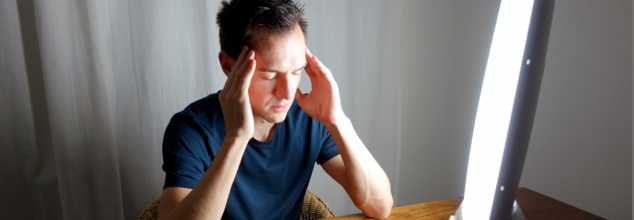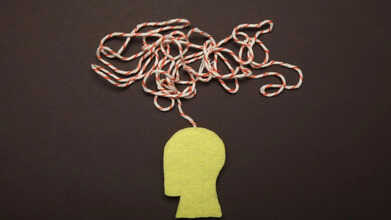- Health Conditions A-Z
- Health & Wellness
- Nutrition
- Fitness
- Health News
- Ayurveda
- Videos
- Medicine A-Z
- Parenting
- Web Stories
How Does Light Therapy Effectively Treat Seasonal Depression?

Image Credit: Canva
The transition from the vibrant days of fall to the dim, gray skies of winter often brings with it a significant change in mood for some individuals. This condition, known as Seasonal Affective Disorder (SAD), is more than a temporary case of the winter blues. SAD, a subcategory of major depressive disorder (MDD), is characterized by a cycle of recurring depressive episodes that begin in late fall and lift with the advent of spring. Light therapy (phototherapy), among other forms of treatment, effectively addresses these symptoms.
SAD is not just a case of getting the blues when cold weather approaches. This is a condition where symptoms resemble clinical depression, including:
- Depression or hopelessness
- Fatigue or low energy
- Sleep disturbances
- Changes in appetite and weight
- Loss of interest in activities
- Difficulty concentrating
- Suicidal thoughts in extreme cases
According to Dr. Rahul Chandhok, Senior Consultant and Head of Psychiatry, "SAD is related to the diminished exposure to sunlight in winter seasons that impacts the serotonin, melatonin, and circadian rhythms control within the brain which controls mood and energy levels."
In case these symptoms occur in the same seasons, it's necessary to see a doctor to determine the appropriate diagnosis and treatment.
Light therapy is the exposure to bright artificial light in order to make up for less natural sunlight when it is darker. According to Dr. Chandhok, "The therapy uses lightboxes that emit bright light to mimic sunlight, helping reset the body's circadian clock and boost mood-regulating neurotransmitters."
Special receptors in the retina forward light signals to the brain, mainly to the superchiasmatic nucleus (SCN)—the body's master clock. SCN governs and modulates the body's sleep-wake cycles, digestive functions, and hormonal responses. Light therapy stimulates the brain's mood-modulating areas: specifically, it can enhance and optimize the emotional-cognitive brain activity of the prefrontal cortex.
Steps to Begin Safe Home Light Therapy
- It is not ideal for everyone; those with some eye problems and bipolar disorder might not be ideal candidates.
- Look for one that is at least 10,000 lux intensity as the standard of effective treatment.
- Use the lightbox within an hour of waking up, typically for 30 minutes daily.
- Place the device at the correct distance and angle, as specified in the instructions, ensuring you don’t stare directly at the light.
This has an effectiveness of around 40% to 60% in symptom improvement, which is comparable with that of antidepressants and CBT. A combination of this treatment with other interventions often leads to greater improvement.
Effective Treatments for Seasonal Depression
Light therapy is the cornerstone of treatment for SAD, but other treatments can complement its therapeutic benefits.
Psychotherapy
Cognitive Behavioral Therapy has also been of use in disrupting these thought patterns that often occur in SAD. Such therapy helps the client recognize more efficiently what causes the problem and how better to cope with stress, and even once the depressive season has passed, this relief can last in the long run.
Medication
For intense episodes, one may be given SSRIs or other classes of antidepressants. These help balance serotonin levels, thus helping alleviate depressive symptoms.
Lifestyle Modifications
- Time spent outdoors is a good activity, even when the sun doesn't shine.
- Physical exercise encourages the secretion of endorphins, natural mood boosters in the human body.
- Maintenance of consistent sleep and wake patterns reinforces the circadian rhythm in the human body.
Role of Prevention and Early Intervention
Proactive measures for seasonal depression will reduce its severity to a considerable extent. The moment you realize the early signs of SAD, take swift action. This can be made possible by undergoing light therapy at the initial stage of symptoms before they aggravate, maintaining social interaction, and being mindful.
According to Dr. Chandhok, "SAD is a treatable condition, but timely intervention is crucial. Early diagnosis and a combination of therapies can restore emotional well-being and improve overall quality of life.
Is Light Therapy Right for You? When to Consult a Doctor
If symptoms of SAD persist or interfere with daily functioning, consult a mental health professional. Severe symptoms, such as thoughts of self-harm or prolonged hopelessness, require immediate attention.
While the dark winter months seem to weigh everything down, hope is provided in the form of light therapy and other evidence-based treatments. By being proactive and getting the right support, even the worst of winter days need not deter people suffering from SAD. No one needs to go through seasonal depression alone.
Dr. Rahul Chandhok is a Sr. Consultant & Head Psychiatry at Artemis Lite NFC, New Delhi in India.
World Polio Day: How the Polio Vaccine Became a Lifesaving Shield Against a Global Disease

Credits: Canva
In the 1970s, India faced nearly 200,000 polio cases each year. This was not unusual, before vaccines became widespread, diseases we now rarely think about, like polio, caused unnecessary death and immense suffering. Measles, for instance, claimed an estimated 2.6 million lives annually before its vaccine was introduced in the early 1960s.
To ensure every child benefits from vaccines and is protected from preventable diseases, we must learn from successful campaigns, including the global effort to eradicate polio.
Since the global push to eliminate polio began in 1988, cases have dropped by 99.9%. India was officially declared polio-free on March 27, 2014, by the World Health Organization (WHO), following the last reported case of wild polio on January 13, 2011, and a subsequent three-year period without any new cases.
This marked one of the most formidable milestones in public health: India—and the entire South-East Asia Region was certified polio-free, despite limited resources and enormous challenges. On World Polio Day, we take a closer look at how the polio vaccine helped the world stop a global threat.
What is Polio?
Poliomyelitis, or polio, is a viral disease that in its early stages can cause fatigue, headaches, stiffness, and limb pain after exposure to the poliovirus, according to the World Health Organization (WHO). About one in 200 infections leads to paralysis, and 5–10% of those paralyzed may die if the disease immobilizes their breathing muscles. While polio mainly affects children under five, anyone who is unvaccinated is at risk.
In the 19th and 20th centuries, frequent polio outbreaks made it one of the most feared diseases in the United States. The deadliest outbreak occurred in 1952, claiming more than 3,000 lives, according to US public health data.
Polio Affected Hundreds Of Thousands Of Americans
The United States faced its worst polio outbreak in 1952, with nearly 58,000 cases of paralysis and just over 3,000 deaths. Thanks to widespread vaccination, polio was eliminated in the country by 1979.
Polio Eradication In India
India launched the Pulse Polio Immunization Programme on 2 October 1994, at a time when the country accounted for nearly 60% of all polio cases worldwide. Two decades later, on 27 March 2014, India was officially declared polio-free by the World Health Organization, following the last reported case in Howrah, West Bengal, on 13 January 2011, according to WHO records.
The success of this campaign hinged on ensuring vaccines reached every child, including those in the most remote and vulnerable communities. Strong commitment at all levels, from policymakers and health authorities to frontline workers, partners, and community volunteers ensured that life-saving polio drops were delivered to children wherever they were, whether at home, in school, or while traveling.
About The Polio Vaccine
The first polio vaccine was developed in the early 1950s by Dr. Jonas Salk and approved for use across the United States in 1955. This injectable, inactivated polio vaccine (IPV) is still in use in some countries today.
In the late 1950s and early 1960s, Dr. Albert Sabin developed a second option: the oral polio vaccine (OPV). Introduced into the US immunization schedule in 1961, it was inexpensive and easy to administer, which helped it become the most widely used polio vaccine in national immunization programs around the world. While it’s no longer used in the US, it remains especially effective in developing countries.
The two main types of polio vaccines are:
Inactivated Polio Vaccine (IPV)
- Introduced in the US in 1955
- The only polio vaccine used in the US since 2000
- Given via injection, requiring a trained health worker and sterile equipment
Oral Polio Vaccine (OPV)
- Introduced in the US in 1961
- The most widely used polio vaccine globally
- Administered orally and can be given by trained volunteers
How Polio Vaccine Saved World From A Health Crisis
Polio vaccines have played a key role in eliminating the wild form of the disease from many parts of the world, including the Americas, Europe, Southeast Asia, and Africa, according to the World Health Organization (WHO). Czechoslovakia was the first country to show that nationwide eradication of wild poliovirus was possible, achieving this in 1960 after a strong vaccination campaign in which roughly 93% of children received the oral polio vaccine.
Despite these successes, wild poliovirus remains endemic in a few regions, notably Afghanistan and Pakistan.
Hidden Signs of Adult ADHD You Might Be Overlooking, According to Experts

Credits: Canva
A doctor has highlighted the subtle signs he often observes in adults with Attention Deficit Hyperactivity Disorder (ADHD). These are traits people with ADHD may recognise in themselves but that are rarely discussed publicly. A consultant psychiatrist has highlighted subtle signs of Attention Deficit Hyperactivity Disorder (ADHD) that often go unnoticed. Dr. Ali Ajaz, who shares advice with over 97,600 TikTok followers, recently outlined six “hidden features” of ADHD that aren’t as widely discussed as the more familiar symptoms. These lesser-known traits can help adults recognise the condition in themselves or others.
What Is ADHD?
Attention-Deficit/Hyperactivity Disorder (ADHD) is a neurodevelopmental condition that begins in childhood and often continues into adulthood. It involves persistent challenges with attention, hyperactivity, and impulsive behaviour. Children with ADHD may struggle in school, face difficulties in relationships, and experience low self-esteem.
While symptoms can lessen over time, many continue to experience them as adults. Although there’s no cure, early diagnosis and a combination of medication, behavioural therapy, and education can significantly improve daily functioning and long-term outcomes.
ADHD Symptoms
The main symptoms of Attention-Deficit/Hyperactivity Disorder (ADHD) include difficulty focusing, impulsive behaviour, and excessive activity levels. Signs of the condition usually appear before the age of 12 and, in some cases, can be noticed as early as age 3. The symptoms can range from mild to severe and must be present in more than one environment, such as home, school, or work to confirm a diagnosis. These behaviours often interfere with growth, learning, and everyday functioning and may persist into adulthood.
ADHD is diagnosed more frequently in boys than in girls, though it can look different between the two. Boys are often more visibly hyperactive, while girls may show quieter patterns of inattention that can easily go unnoticed.
There are three main types of ADHD:
1. Predominantly Inattentive Type:
Individuals mainly struggle with concentration, organisation, and completing tasks. They may appear forgetful or easily distracted
2. Predominantly Hyperactive-Impulsive Type:
This form involves restlessness, excessive movement, and impulsive decisions. The person may act without considering the consequences or have difficulty sitting still.
3. Combined Type:
This type includes a mix of inattentive and hyperactive-impulsive symptoms, meeting the criteria for both categories.
Hidden Signs of Adult ADHD
Dr Ali Ajaz in his recent tiktok video talked about less than the 'classic' signs of the condition.
According to the doctor, people with ADHD often show certain behaviours that are rarely discussed but are quite common. One of them is hyperfocus which is getting so engrossed in something that they completely lose track of time. While this can be an advantage in some situations, it often causes them to ignore other responsibilities or personal needs.
Another sign is having an unusually high or low sex drive. For some, sex serves as a form of stimulation or a way to release tension, while for others, it feels like too much effort and concentration, leading to disinterest.
He also mentioned binge eating, explaining that the ADHD brain constantly seeks stimulation, and food becomes an easy source of instant gratification. Finally, he pointed out rejection sensitivity, where even mild criticism can feel deeply hurtful, often resulting in overthinking and emotional withdrawal.
The doctor went on to explain that low self-esteem and self-doubt are also very common among people with ADHD. These feelings often come from years of struggling with symptoms, either being told they are not trying hard enough or putting in their best effort but still falling short of expectations. Over time, this combination can deeply affect confidence and self-worth.
Lastly, he mentioned chronic gut problems such as bloating, pain, constipation, or diarrhoea. These issues, he said, are closely linked to the gut-brain connection, as ADHD brains often show signs of inflammation. Much of this inflammation, he explained, comes from diet and eating patterns.
This Common Antidepressant May Quietly Raise Your Blood Pressure, Even As It Helps You Lose Weight

Credits: Canva
Antidepressants side effects weight gain: Antidepressants, widely used to manage mental health conditions, can affect weight, heart rate, and blood pressure, though these changes differ depending on the specific drug. Researchers from King’s College London’s Institute of Psychiatry, Psychology & Neuroscience (IoPPN) conducted one of the most extensive reviews to date, comparing the physical effects of 30 antidepressants. The findings, published in The Lancet, draw on data from over 150 clinical trials involving 58,534 participants who took either antidepressants or placebos for eight weeks.
This Common Antidepressant May Quietly Raise Your Blood Pressure
The researchers observed the biggest differences in weight, heart rate, and blood pressure among those taking antidepressants. They said the results, published in The Lancet, are meant to help patients make informed decisions but advised anyone with concerns to consult their doctor.
Researchers examined how these medications affected patients during the first eight weeks of treatment. Some antidepressants led to weight gains of up to 2 kilograms, while others caused changes in heart rate of as much as 21 beats per minute.
What Is Sertraline?
Sertraline, sold under the brand name Zoloft, is a prescription antidepressant medication that belongs to the class of drugs known as selective serotonin reuptake inhibitors (SSRIs). It works by increasing the levels of serotonin, a natural chemical in the brain that helps regulate mood.
Between 2024 and 2025, about 92.6 million antidepressant prescriptions were issued to roughly 8.89 million people in England, according to data from the NHS Business Services Authority (NHSBSA). Among them, sertraline, taken by an estimated 2.9 million patients, was associated with slight weight loss, averaging about 0.76 kilograms, and a small drop in heart rate. However, it also showed a modest rise in both systolic and diastolic blood pressure.
Sertraline Leads To Increased Blood pressure
An increase in blood pressure can raise the risk of stroke, the researchers noted. However, they also pointed out that the study’s main limitation was its short duration, as it only examined the first eight weeks of treatment. They said more research is needed to understand the longer-term effects of these medications.
Dr. Toby Pillinger, lead researcher and consultant psychiatrist at King’s College London, stressed that the findings are not intended to discourage antidepressant use. Instead, they aim to promote personalised treatment and encourage shared decision-making between doctors and patients, empowering individuals to make more informed choices about their care.
Which Antidepressant Should I Opt For?
The most commonly prescribed antidepressants—SSRIs like paroxetine, citalopram, escitalopram, and sertraline, generally showed fewer physical side effects. Professor Andrea Cipriani from the University of Oxford said it is “impossible” to determine how many of the millions taking antidepressants might benefit from a different medication.
He noted that a focus on “generic, cheap medications” has led to 85% of antidepressant prescriptions in the UK being for just three SSRIs: citalopram, sertraline, and fluoxetine.
According to Cipriani, applying the findings from this study could drastically reduce that 85% figure, allowing more patients to access treatments better suited to their needs.
The research team is also developing a free online tool to help doctors and patients make more informed choices about which antidepressant to use.
© 2024 Bennett, Coleman & Company Limited

